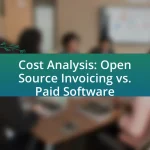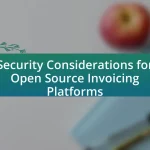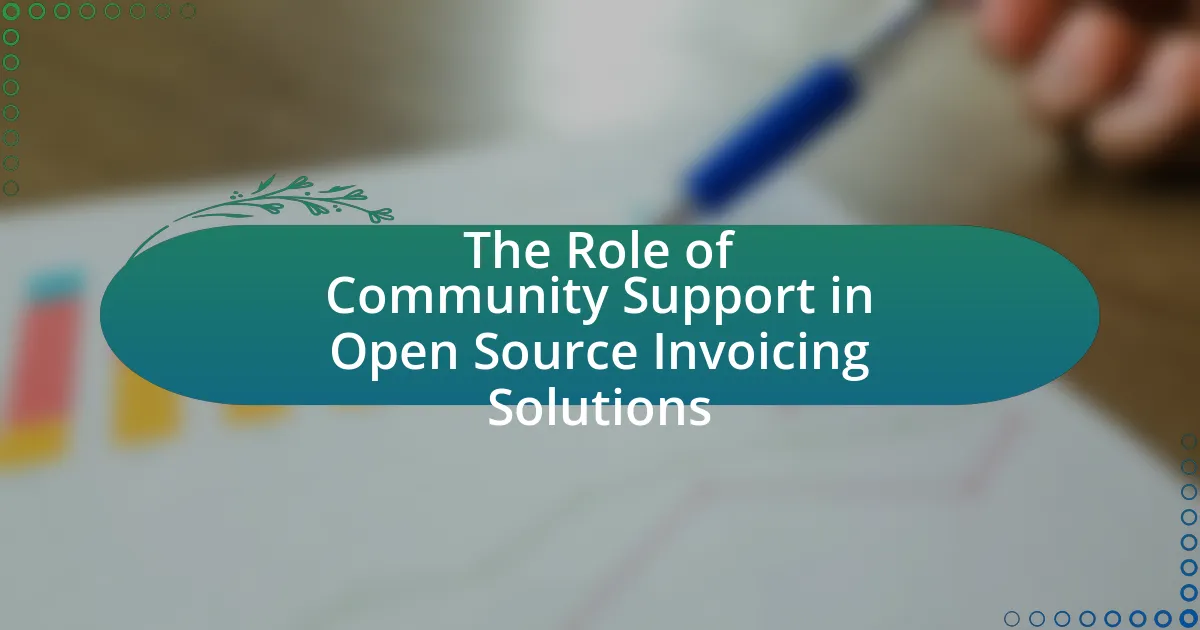Migrating from proprietary invoicing solutions to open source alternatives involves transitioning to software that is freely available for use, modification, and distribution. This shift offers businesses benefits such as cost savings, increased flexibility, and enhanced customization options, while addressing limitations like vendor lock-in and high licensing fees associated with proprietary systems. The article outlines the advantages of open source invoicing solutions, key features, potential challenges during migration, and best practices for ensuring a smooth transition. It emphasizes the importance of thorough planning, staff training, and ongoing support to maximize the benefits of open source invoicing systems.
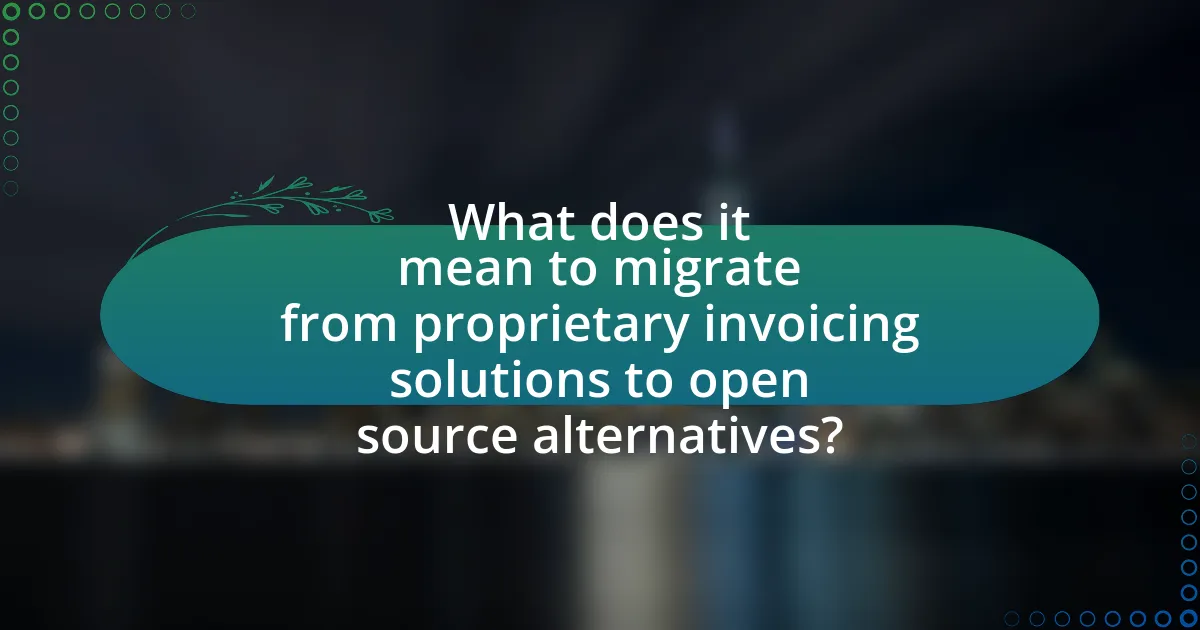
What does it mean to migrate from proprietary invoicing solutions to open source alternatives?
Migrating from proprietary invoicing solutions to open source alternatives means transitioning from software that is owned and controlled by a specific company to software that is freely available for use, modification, and distribution. This shift allows businesses to avoid vendor lock-in, reduce costs associated with licensing fees, and gain greater flexibility in customizing their invoicing processes. Open source solutions often foster community support and collaboration, which can lead to more rapid updates and improvements compared to proprietary systems. For instance, according to a 2021 report by the Open Source Initiative, organizations that adopt open source software can save up to 30% on software costs, highlighting the financial benefits of such a migration.
Why consider migrating to open source invoicing solutions?
Migrating to open source invoicing solutions is beneficial due to cost savings, flexibility, and control over software customization. Open source solutions eliminate licensing fees associated with proprietary software, allowing businesses to allocate resources more efficiently. Additionally, these solutions offer the ability to modify the software to meet specific business needs, enhancing operational efficiency. According to a 2021 report by the Open Source Initiative, organizations that adopt open source software can save up to 30% on software costs compared to proprietary alternatives. This combination of financial savings and increased adaptability makes open source invoicing solutions an attractive option for businesses looking to optimize their invoicing processes.
What are the limitations of proprietary invoicing solutions?
Proprietary invoicing solutions have several limitations, including high costs, lack of customization, vendor lock-in, and limited integration capabilities. High costs arise from licensing fees and ongoing maintenance expenses, which can strain budgets, especially for small businesses. The lack of customization restricts users from tailoring the software to their specific needs, leading to inefficiencies. Vendor lock-in occurs when businesses become dependent on a single provider, making it difficult to switch to alternative solutions without incurring significant costs or disruptions. Additionally, limited integration capabilities hinder the ability to connect with other essential business tools, reducing overall operational efficiency. These factors collectively make proprietary invoicing solutions less flexible and adaptable compared to open-source alternatives.
How can open source alternatives address these limitations?
Open source alternatives can address the limitations of proprietary invoicing solutions by providing customizable features, cost-effectiveness, and enhanced transparency. Customization allows businesses to tailor the software to their specific needs, overcoming the rigidity often found in proprietary systems. Cost-effectiveness is evident as open source solutions typically have no licensing fees, reducing overall expenses for businesses. Enhanced transparency is achieved through open access to the source code, enabling users to audit and modify the software, which mitigates security concerns associated with proprietary solutions. These factors collectively empower organizations to create more efficient and secure invoicing processes.
What are the key features of open source invoicing solutions?
Open source invoicing solutions typically feature customizable templates, allowing users to tailor invoices to their branding needs. These solutions often include multi-currency support, enabling businesses to invoice clients in different currencies seamlessly. Additionally, they provide integration capabilities with various accounting and payment systems, enhancing workflow efficiency. User access controls are another key feature, allowing businesses to manage permissions for different team members. Furthermore, open source invoicing solutions usually offer detailed reporting and analytics tools, enabling users to track financial performance effectively. These features collectively enhance usability, flexibility, and control over invoicing processes.
How do customization options differ between proprietary and open source solutions?
Customization options differ significantly between proprietary and open source solutions. Proprietary solutions typically offer limited customization due to their closed-source nature, restricting users to predefined features and functionalities set by the vendor. In contrast, open source solutions provide extensive customization capabilities, allowing users to modify the source code, add new features, and tailor the software to meet specific business needs. This flexibility is supported by a community of developers who contribute to the software, enabling continuous improvement and adaptation. For example, according to a 2021 report by the Open Source Initiative, 78% of organizations using open source software cited customization as a key benefit, highlighting the advantages of open source in meeting unique requirements.
What security advantages do open source invoicing solutions offer?
Open source invoicing solutions offer enhanced security advantages due to their transparency and community-driven development. The open-source nature allows users to inspect the source code for vulnerabilities, ensuring that any security flaws can be identified and addressed quickly by the community. Additionally, these solutions benefit from continuous updates and patches contributed by a global network of developers, which helps to mitigate risks associated with outdated software. According to a study by the European Union Agency for Cybersecurity, open-source software is often more secure than proprietary software because it undergoes rigorous peer review, leading to faster identification and resolution of security issues.
What challenges might arise during the migration process?
During the migration process from proprietary invoicing solutions to open source alternatives, challenges such as data compatibility, user training, and system integration may arise. Data compatibility issues occur when the formats or structures of data in proprietary systems do not align with those in open source solutions, potentially leading to data loss or corruption. User training challenges stem from the need for staff to adapt to new software interfaces and functionalities, which can result in decreased productivity during the transition period. Additionally, system integration challenges may arise when attempting to connect the new open source solution with existing business systems, leading to potential disruptions in workflow. These challenges are commonly reported in case studies and migration analyses, highlighting the importance of thorough planning and testing during the migration process.
How can data migration be effectively managed?
Data migration can be effectively managed by implementing a structured plan that includes assessment, mapping, testing, and execution. First, organizations should assess the existing data to understand its structure, quality, and relevance. Next, mapping involves defining how data from the proprietary system will correspond to the open-source alternative, ensuring compatibility and integrity. Testing is crucial; it involves running pilot migrations to identify potential issues before full-scale execution. Finally, executing the migration with continuous monitoring allows for immediate troubleshooting and validation of data integrity. According to a study by Gartner, organizations that follow a structured approach to data migration experience up to 30% fewer issues post-migration, highlighting the importance of these steps.
What training will staff need to adapt to new systems?
Staff will need comprehensive training on the new open-source invoicing system, including its functionalities, user interface, and integration processes. This training should encompass hands-on workshops, online tutorials, and documentation review to ensure staff can effectively navigate and utilize the system. Additionally, training should cover data migration techniques and troubleshooting common issues, as these are critical for a smooth transition from proprietary solutions. Evidence from successful migrations indicates that organizations that invest in thorough training experience a 30% reduction in operational disruptions during the transition period.
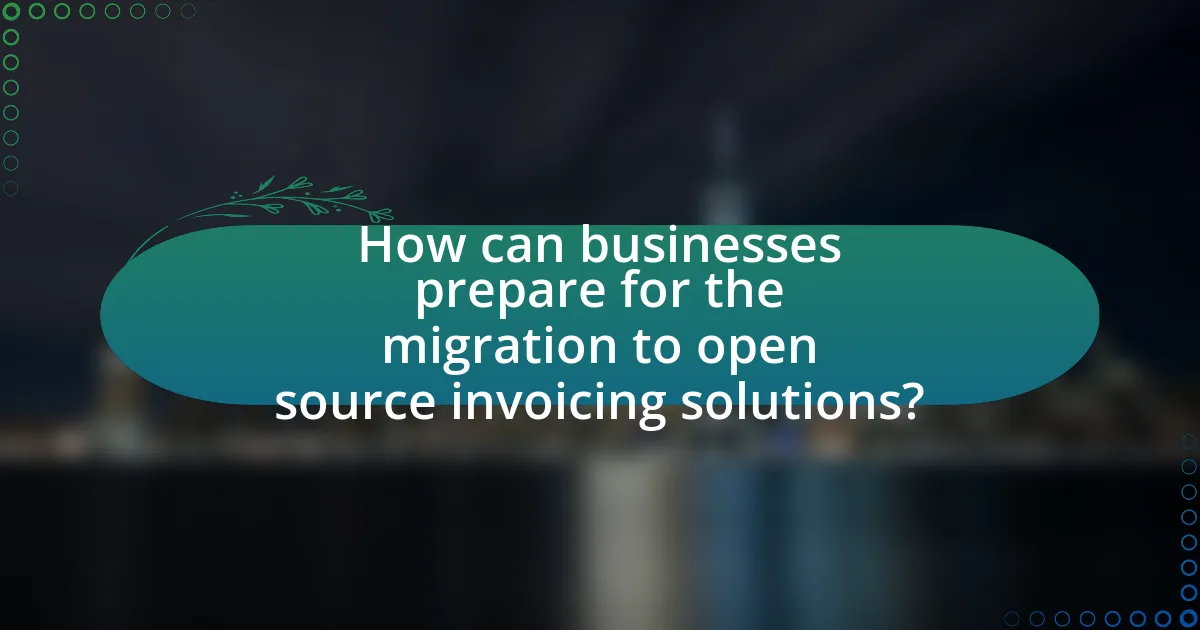
How can businesses prepare for the migration to open source invoicing solutions?
Businesses can prepare for the migration to open source invoicing solutions by conducting a thorough assessment of their current invoicing processes and identifying specific needs. This involves evaluating existing software capabilities, understanding user requirements, and determining integration points with other systems. Additionally, businesses should establish a clear migration plan that includes timelines, resource allocation, and training for staff on the new open source platform. Research indicates that organizations that invest in training and change management during software transitions experience a 70% higher success rate in adoption (Prosci, 2021). By following these steps, businesses can ensure a smoother transition to open source invoicing solutions.
What steps should be taken before initiating the migration?
Before initiating the migration from proprietary invoicing solutions to open source alternatives, it is essential to conduct a thorough assessment of the current invoicing system. This assessment should include evaluating the existing data, understanding the specific requirements of the business, and identifying any potential compatibility issues with the new open source solution. Additionally, it is crucial to create a detailed migration plan that outlines the timeline, resources needed, and risk management strategies. This structured approach ensures a smooth transition and minimizes disruptions to business operations.
How can businesses assess their current invoicing needs?
Businesses can assess their current invoicing needs by analyzing their transaction volume, invoice complexity, and payment methods. Evaluating the frequency of invoicing, the types of services or products sold, and the customer base helps identify specific requirements. For instance, a business processing over 1,000 invoices monthly may require automated solutions, while a smaller operation might manage with manual invoicing. Additionally, reviewing existing software capabilities and identifying gaps in features such as reporting, integration, and user experience can further clarify invoicing needs. This assessment ensures that businesses select an invoicing solution that aligns with their operational demands and growth objectives.
What criteria should be used to select an open source invoicing solution?
To select an open source invoicing solution, consider criteria such as functionality, user interface, community support, security, and integration capabilities. Functionality should meet specific invoicing needs, including features like recurring billing and expense tracking. A user-friendly interface enhances usability, while strong community support ensures ongoing development and troubleshooting assistance. Security features, such as data encryption and compliance with regulations, protect sensitive financial information. Lastly, integration capabilities with existing systems, such as accounting software, facilitate seamless operations. These criteria are essential for ensuring the chosen solution effectively meets business requirements and provides long-term viability.
How can businesses ensure a smooth transition to open source solutions?
Businesses can ensure a smooth transition to open source solutions by conducting thorough planning and assessment of their current systems. This involves evaluating existing proprietary software to identify specific needs and compatibility issues with open source alternatives. Additionally, businesses should engage stakeholders early in the process to gather input and foster buy-in, which can facilitate a more seamless transition. Training staff on the new open source tools is crucial, as it enhances user adoption and minimizes disruptions. Furthermore, establishing a phased implementation strategy allows for gradual integration, reducing risks associated with sudden changes. Research indicates that organizations that adopt a structured approach to migration experience fewer operational challenges and greater overall satisfaction with their new systems.
What role does stakeholder involvement play in the migration process?
Stakeholder involvement is crucial in the migration process as it ensures that the needs and concerns of all parties affected by the change are addressed. Engaging stakeholders, such as employees, management, and customers, facilitates a smoother transition by fostering collaboration and gathering diverse perspectives. Research indicates that projects with active stakeholder participation are 20% more likely to succeed, as they help identify potential challenges early and promote buy-in for the new system. This involvement leads to better alignment of the migration strategy with organizational goals, ultimately enhancing the effectiveness of the transition from proprietary invoicing solutions to open source alternatives.
How can businesses create a timeline for the migration?
Businesses can create a timeline for migration by first assessing their current invoicing processes and identifying key milestones for the transition. This involves mapping out the stages of migration, such as planning, data migration, system testing, and user training, and assigning specific timeframes to each stage. For instance, a typical migration timeline may allocate two weeks for planning, four weeks for data migration, and three weeks for testing and training. Establishing clear deadlines helps ensure accountability and facilitates tracking progress. Additionally, utilizing project management tools can enhance visibility and coordination among team members, further supporting the timeline’s effectiveness.
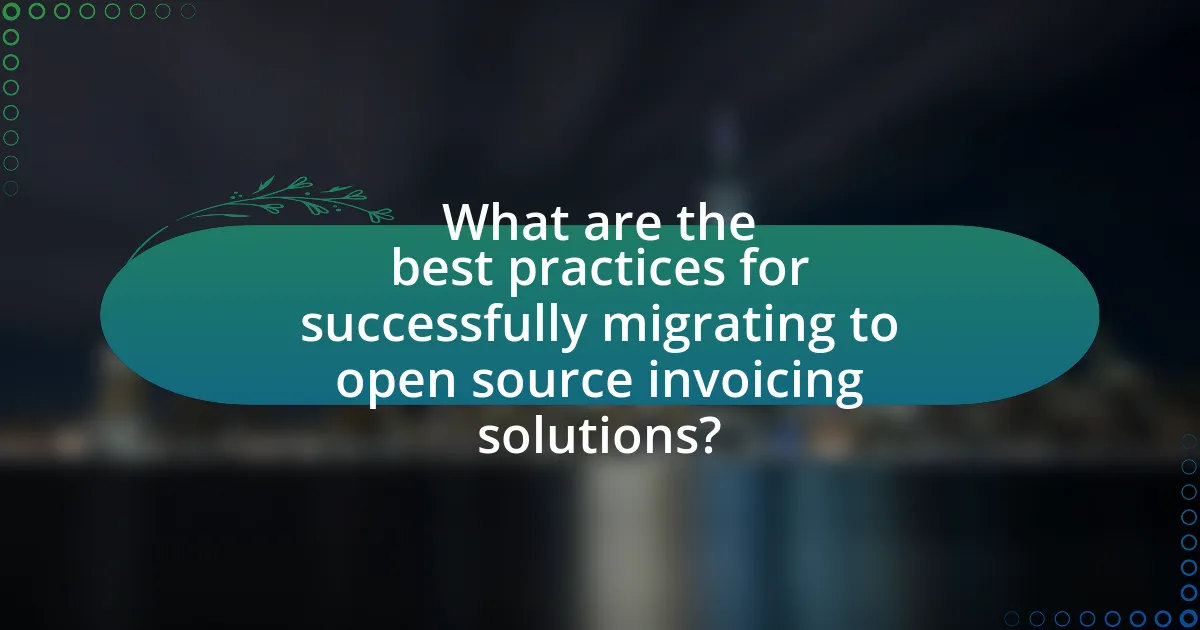
What are the best practices for successfully migrating to open source invoicing solutions?
The best practices for successfully migrating to open source invoicing solutions include thorough planning, data backup, and staff training. First, organizations should conduct a comprehensive assessment of their current invoicing processes and identify specific needs that the open source solution must meet. This ensures that the chosen software aligns with operational requirements. Next, backing up all existing data is crucial to prevent loss during the transition. Additionally, providing adequate training for staff on the new system enhances user adoption and minimizes disruptions. Research indicates that organizations that invest in training experience a 30% increase in productivity post-migration. Finally, engaging with the open source community can provide valuable support and resources, facilitating a smoother transition.
How can businesses maintain data integrity during migration?
Businesses can maintain data integrity during migration by implementing a comprehensive data validation process. This involves verifying data accuracy and completeness before, during, and after the migration. Techniques such as data profiling, which assesses the quality of data, and checksum validation, which ensures data consistency, are essential. According to a study by IBM, poor data quality can cost organizations an average of $15 million annually, highlighting the importance of rigorous data integrity measures during migration. Additionally, conducting pilot migrations can help identify potential issues early, allowing businesses to address them proactively.
What tools can assist in the data migration process?
Data migration tools that can assist in the process include Talend, Apache NiFi, and AWS Database Migration Service. Talend provides a comprehensive suite for data integration and migration, allowing users to connect various data sources and perform transformations. Apache NiFi offers a user-friendly interface for automating data flows between systems, making it suitable for real-time data migration. AWS Database Migration Service simplifies the migration of databases to AWS, supporting various database engines and minimizing downtime during the transition. These tools are widely recognized for their effectiveness in facilitating seamless data migration, ensuring data integrity and efficiency.
How can businesses test the new system before full implementation?
Businesses can test the new system before full implementation by conducting a pilot program or a phased rollout. This approach allows businesses to evaluate the system’s functionality, gather user feedback, and identify potential issues in a controlled environment. For instance, a pilot program can involve a small group of users who utilize the new system for a limited time, enabling the business to assess performance metrics and user satisfaction. According to a study by the Project Management Institute, organizations that implement pilot programs report a 20% increase in project success rates, highlighting the effectiveness of this testing method.
What ongoing support is necessary after migration?
Ongoing support after migration includes regular system updates, user training, and technical assistance. Regular system updates ensure that the open-source software remains secure and functional, as vulnerabilities can be discovered over time. User training is essential to help staff adapt to the new system, maximizing efficiency and minimizing errors. Technical assistance provides users with help in troubleshooting issues, ensuring that any problems are resolved quickly to maintain workflow continuity. These support elements are critical for a successful transition from proprietary solutions to open-source alternatives, as they help mitigate risks associated with software changes and enhance user satisfaction.
How can businesses ensure continuous improvement of the invoicing process?
Businesses can ensure continuous improvement of the invoicing process by implementing regular audits and feedback mechanisms. Regular audits help identify inefficiencies and errors in the invoicing workflow, while feedback from employees and customers provides insights into areas needing enhancement. For instance, a study by the Institute of Management Accountants found that organizations that regularly review their processes can reduce invoicing errors by up to 30%. Additionally, adopting automation tools can streamline the invoicing process, further enhancing accuracy and efficiency. By combining these strategies, businesses can create a dynamic invoicing system that evolves with their needs.
What resources are available for troubleshooting and support?
For troubleshooting and support during the migration from proprietary invoicing solutions to open source alternatives, users can access several resources. These include official documentation provided by the open source software, community forums where users share experiences and solutions, and dedicated support channels such as GitHub issues or mailing lists. Additionally, many open source projects have active communities on platforms like Discord or Slack, where real-time assistance can be obtained. These resources are validated by the collaborative nature of open source projects, which often rely on community contributions and shared knowledge to resolve issues effectively.
What tips can help businesses maximize the benefits of open source invoicing solutions?
To maximize the benefits of open source invoicing solutions, businesses should prioritize customization, community engagement, and regular updates. Customization allows businesses to tailor the software to their specific needs, enhancing functionality and user experience. Engaging with the open source community fosters collaboration, providing access to shared knowledge, troubleshooting support, and potential enhancements. Regular updates ensure that the software remains secure and incorporates the latest features, which is crucial for maintaining efficiency and compliance. These strategies collectively enhance the effectiveness and reliability of open source invoicing solutions, leading to improved operational performance.

